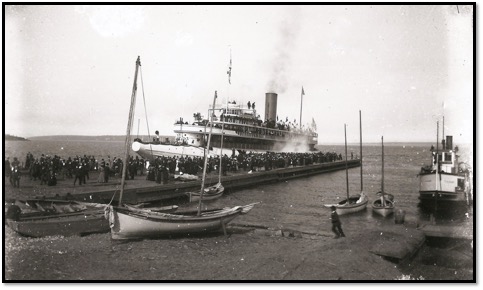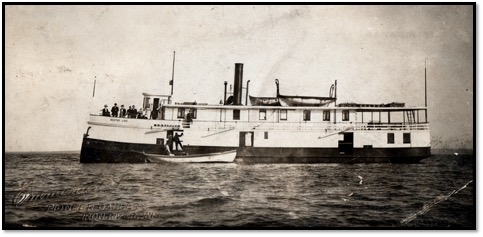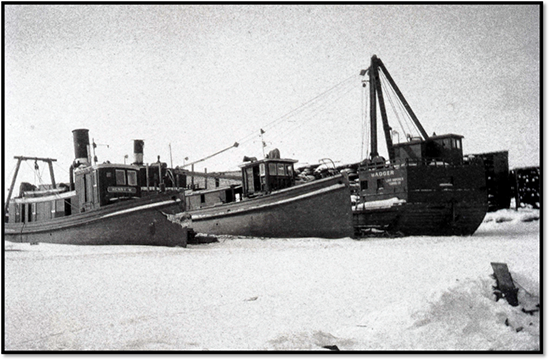Christopher Columbus Visits Bayfield
County Press
September 25, 1897

Christopher Columbus, Mackinaws and the T. H. Camp Dalrymple dock on September 19, 1897 Photo Bayfield Heritage Association
Professor Deer Made a Successful Ascension from the Deck of the CHRISTOPHER COLUMBUS read the headlines this day. The two largest crowds that ever visited Bayfield were landed here last Saturday and Sunday by the big whaleback steamer CHRISTOPHER COLUMBUS. Fully 8000 excursionists visited the Harbor City. Sunday was the last trip for the Christopher and closed the most successful season in her experience.
On Saturday the CHRISTOPHER landed at the Dalrymple dock with over 2000 people on board. She remained at the dock one hour, during which time the excursionists took in the sights of the town.
Professor Deer made an attempt at balloon ascension while in the harbor. The balloon was held on the windward side by 15 or 20 men, but when two thirds inflated a heavy gust of wind caught it piling up the men in a heap, the boom swept the deck, knocking over the hot air flue and set it on fire. The men immediately let go of the guy ropes and the large airship blew over into the water where the flames were extinguished. Considerable excitement prevailed, causing two ladies to faint, fortunately no one was injured.
Here is what the Superior Evening Telegram has to say of Sunday’s excursion: “Sunday’s excursion was a success. While the weather was cold there was a lesson on Saturday and the scenes of hundreds of people leaning over the railings, ostensibly to look at the water were not repeated. On Saturday the crowd got sick by the hundreds. Many did not enjoy the trip on this account and lunch baskets were not touched. About 4000 people were on the excursion of Saturday and the same number Sunday.
The balloon ascension was of course one of the principal attractions. On Saturday several attempts were made to raise the affair, the last one being at Bayfield. There a gust of wind took a fall out of the airship and a big hole was accidentally burned in the canvas which leaned the balloon up for repairs. Sunday the airship was repaired, and when the CHRISTOPHER was lying at the dock at Bayfield during our stop, the ascension was made. The balloon was inflated with hot air upon the forward deck, and an additional staff being erected to hold a canvas in place during the process. It took about 15 minutes to inflate the balloon as a dozen men held her down as it’s constantly increasing size doubled its efforts to get away.
Suddenly there was a signal. The man on the guy ropes released their hold and the balloon shot upward. It was one of the prettiest aeronautic performances ever seen. Suspended from the bottom of the balloon proper was a parachute. Suspended from the parachute was the trapeze, and as the balloon left the deck at the rates of a mile in about eleven seconds Professor Patsy G. Deer was seen hanging by his feet from the bar. An instant later he reversed his position and held on by his teeth.
It seemed an incredibly short time but the balloon was up in the air between 3000 and 4000 feet when the professor pulled a string and let the parachute off. Down it shot with the professor dangling at the trapeze. Inside of three hundred feet the parachute opened like a huge white canvas umbrella and swung slowly down to terra-firma. A good many people thought the dissent even at this was too fast for comfort. Professor Deer landed a few hundred feet back from the lake in Bayfield, safe and sound.
The balloon, now the size of a hen’s egg, was rapidly emptying its hot air. Relieved of the weight which had kept the opening below; it turned bottom up and came down in the top of some trees. Ten seamen from the CHRIS were waiting for it and picked it up, bringing it on shipboard and the vessel immediately pulled away.
The COLUMBUS stopped Sunday at Two Harbors, Minnesota and took on a good crown from there. Duluth was left at 10:30 and Two Harbors was reached at noon. At four o’clock they were at Bayfield and left there at 5 PM. The day despite its coldness was pleasant. The South Superior band on board furnished music and the big main cabin was filled to overflowing at all times. The big crowds carried by the CHRIS demonstrate that she is easily the most popular excursion steamer on the lakes. She goes into winter quarters at the Barge Company’s plant in Superior and preparations are now being made to lay her up until next spring.
Historical Facts: The Whaleback vessel CHRISTOPFER COLUMBUS was built by American Steel Barge Company at West Superior, Wisconsin, by Mr. Alex McDougal for Columbia Whaleback Steam Ship Company of New York in 1893. The 362’ x 42 abeam, draft 24’ 3 decked all steel excursion steamer was assigned an official number registration number 126952 and a hull number of 128. Propeller driven under the influence of 6 boilers and a triple expansion 3042 horsepower steam engine the CHRIS was built to transport tourists at the Chicago World’s Fair 1893 at a clip of 20 mph. Her gross tonnage amounted to 1511.05 Tons; net tonnage at 945.95 with a carrying capacity of 5000 passengers. CHRISTOPFER COLUMBUS final resting location was Manitowoc, WI 1936 where she was scrapped with the metal sold to Japan. C. Patrick Labadie, http://greatlakeships.org/2904877/data?n=1]
S. B. Barker C 1883 – 1893
“The Wisconsin Central’s new passenger boat S. B. Barker arrived from below and commenced making regular trips between Ashland and this place Thursday. The Barker is a new boat, this being her second season, is 100 feet long, 18 feet of beam, and 7 1/2 feet depth of hold. She has a carrying capacity of 350 passengers; has large and finely finished cabin and can make her 15 knots an hour. She presented a handsome appearance as she steamed up the harbor Thursday, making all her colors set in four large streamers with white ground and blue border, and bearing in the center of the words, Bayfield – Ashland – Apostle Islands – Duluth, being the names of the several points between which she will ply this season”. Bayfield County Press, May 26, 1883

S.B. Barker meeting up with commercial fishermen, C early 1900’s Robert J. Nelson Luick Postcard Collection Bayfield Heritage Museum Image Apostle Island Historical Preservation Conservancy Ima
While located in Bayfield, the BARKER, served as a tour, packet, herring fisher and Apostle Island fish pick-up transport. When the Chicago, St. Paul, Minneapolis & Omaha rail road arrived to Bayfield in 1883, the BARKER was no longer needed as a passenger vessel. At this time A. Booth Fisheries of Chicago, with a distribution center located in Bayfield, purchased her for their fishery and transport purpose. BMM- Robert J. Nelson
Historical Facts: Title S. B. BARKER – # 115,837; Built 1882 at a cost of $30,000; 1882 Owned Frank R. Brower et al. Holland, MI; ran South Haven, MI-Chicago, IL. 1883-88 Chartered by Wisconsin Central Railroad and ran from Ashland to Bayfield, WI. March 6, 1888: Owned by Cornelius O. Flynn & John G. Howard; ran Duluth-Two Harbors, MN. 1890 Boiler replaced; 1891 Owned Charles S. Morrow (Morrill) & Fred W. Smith; 1892 Rebuilt 96.2 x 17 x 8.5; 94.16 gross/76.80 net tons; April 13, 1892: Owned Smith Fee Co.; ran Duluth-Ashland, WI.; 1893 Rebuilt as 96.2 x 17 x 8.7; 176.69 gross/131.01 net tons; passenger & package freight vessel; owned A. Booth Packing Co.; put on “South Shore route”, Duluth-Apostle Islands; 1913 Tonnage change 146 gross/99 net tons; 1918 Tonnage change 88 gross/50 net tons. Renamed the GLOBE. 1920 the BARKER is owned by Baker & Stewart Lumber Co, Ashland, WI. 1925 Abandoned. Last owned James J. Pendergast, Buffalo, NY. Source From Great Lakes Maritime Data Base- Hugh McKenzie & C. Patrick Labadie, http://greatlakeships.org/2897295/data?n
True Hometown Built
On February 18, 1909 Einer “Shine” Miller, William Duquette, both licensed tug boatmen and Henry W. Wachsmuth, of Wachsmuth Lumber Company filed Articles of Incorporation, Chapter 86, with the State of Wisconsin for the purpose of establishing a tug boat corporation.
The Corporation’s intent was to join the active and profitable log raft and towing industry. From the beaches of the south shore of Lake Superior to the harbors of Minnesota towns like Grand Marais for valuable saw mill, and later until the early 1970’s, paper mill cordage, these floating powerhouses towed huge volumes of softwood, 5000 to 10,000 cords.
As the pine and spruce became scarcer the Apostle were targeted for cutting of local softwoods and hardwoods like Maple, Oak and Birch. Here tug Bayfield would hook up with a scow-barge for a pull to mills in Bayfield, Washburn and Ashland.

Tug Bayfield, Spring of 1909
James and Marge Miller Family Collection
To meet the expanding market demands of the local mills Bayfield’s newly formed Lake Superior Towing Company’s first task was to build their own tug boat towing inventory, starting with flagship, Bayfield.
November 30, 1908: the Bayfield County Press informed the public that the corporation was ready to build their flag-ship Bayfield and offered “Lake Superior Towing Company Completes Arrangements for New Tug; Work Has Already Commenced; Fred Maynard , a Former Bayfielder has Charge of the Construction Work that were the subtitles this week.
“The Lake Superior Towing Company of this city has completed arrangements for the construction here this winter of a new tug. The tug Bayfield will be constructed to take the place of the tug Emmett which this company used during the past season, and which was formerly the property of Captain Charles Leihy. The machinery of the Emmett will be transferred to the hull of the new vessel upon its completion. Fred Maynard, formerly of this city, now of Duluth, has charge of the work which is now well underway.
The Bayfield, when completed, will be very substantial and will be one of the best of its kind on Lake Superior. It will be constructed of white oak timber, will be 85 feet long and have an 18 foot beam and a depth of 10 feet. Altogether about $8000 will be expended in the construction of the boat and together with the machinery owned by the company, the boat will be a fine one.” This work would be completed on the south beach of Bayfield, between 2nd Street and Broad Str.
April 23, 1909: the Bayfield County Press followed with “The new tug, “Bayfield,” constructed here this winter for the towing company, will be ready Monday or Tuesday and will probably start out to bring in rafts to the mills in the city and Washburn and at Ashland. The Stearns Lumber Company has contracts with the local companies for the cutting of about 120,000,000 feet of timber the summer. The Bayfield will be assisted in the work by two other tugs and a gasoline boat.
Bayfield’s namesake was beached circa 1956 in her last port of call, where she was sunk in the Kaministiquia River that empties near Fort Arthur-Fort William, Thunder Bay, Ontario.

Lake Superior Towing Company’s Tugs Henry W, Bayfield and the Scow-barge Badger
Bayfield Heritage Association Image 1980.49.80
